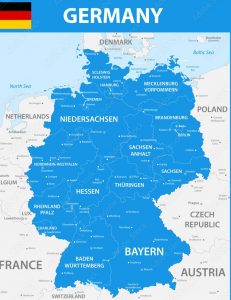🔊German Level 4, Activity 12: Deutsche Dialekte / German Dialects (Online)

Description: Students will learn about varying dialects from different parts of German speaking countries. Students will also have the opportunity to try speaking / saying words and terms in said dialects.
Semantic Topics: Dialects, Schwäbische Dialekte, Hessian, Bremen, Akzente, new dialect vocabulary, neues Dialektvokabular.
Products: Diverse dialects in German speaking countries. Diverse Dialekte im deutschsprachigen Raum.
Practices: The various use of forms of discourse in specific regions of German speaking countries. Die unterschiedliche Verwendung von Diskursformen in bestimmten Regionen des deutschsprachigen Raums.
Perspectives: Value associated with regional, cultural verbal expression in German speaking lands. Wert verbunden mit regionalem, kulturellem Sprachausdruck im deutschsprachigen Raum.
- Standard 2.1 Students demonstrate an understanding of the relationship between the practices and perspectives of the cultures studied.
- Standard 3.1 Students reinforce and further their knowledge of other disciplines through German.
Idaho State Content Standards:
- Objective: CLTR 1.1 Analyze the cultural practices/patterns of behavior accepted as the societal norm in the target culture.
- Objective: CONN 1.1 Observe formal and informal forms of language.
NCSSFL-ACTFL Can-Do Statements:
- I can recognize different dialects from German speaking countries.
- I can compare words from different German speaking countries.
- I can talk about which dialects I prefer and why.
Materials Needed:
Warm-Up
1. Discuss the Can-Do Statements with the Students
2. Have students guess / say what the word is in the respective German speaking country.
Wie heiße ich in Deutschland / Österreich ?
-
- What are bread rolls called in Austria and Germany?
- Austria: die Semmel
- Germany: das Brötchen
- What are stairs called in Austria and Germany?
- Austria: die Stiege
- Germany: die Treppe
- What are potatoes called in Austria and Germany?
- Austria: der Erdapfel
- Germany: die Kartoffel
- What are bread rolls called in Austria and Germany?
3. Discussion Question:
- Habt ihr schon einmal deutsche Dialekte gehört? Wenn ja, könntet ihr sie verstehen? Gefällt sie ihr?(Have you ever heard German dialects? If so, could you understand it? Do you like it?)
Main Activity
1. Students will watch the following videos and guess where the dialect is from.
-
- Video One – Wien, Österreich
- Video Two – Österreich-Tirol
- Video Three – Der Schweiz
2. They will then answer the same questions for each video:
- Woher kommt dieser Dialekt? (Where does this dialect come from?)
- Könnt ihr das überhaupt verstehen? (Could you understand any of it?)
3. Students will then watch a video on how to speak in a Hessian dialect.
Jetzt wird ihr lernen, in einem hessischen Dialekt zu sprechen.
Students will go through slides 17 – 23 and practice speaking in different dialects. The sentence in dialect will be shown first and then the meaning in hochdeutsch will appear after.
Wrap-Up
Ask students the following question(s) to finish the activity:
- Welchen Dialekt gefällt ihr am meisten? (Which dialect do you like the most?)
- Welchen Dialekt gefällt ihr am wenigsten? (Which dialect do you like the least?)
- Welchen Dialekt könntet ihr am besten verstehen? (Which dialect could you understand the best?)
- Wenn ihr einen Dialekt lernen müsst, welchen würdet ihr wählen? (If you had to learn a dialect, which one would you choose?)
End of Activity:
- Read Can-Do statements once more and have students evaluate their confidence. (Use thumbs up/thumbs down)
- Encourage students to be honest in their self-evaluation.
- Pay attention, and try to use feedback for future activities!
NCSSFL-ACTFL Can-Do Statements:
- I can recognize different dialects from German speaking countries.
- I can compare words from different German speaking countries.
- I can talk about which dialects I prefer and why.
Cultural Resources
Here is an Easy German video, Regional German Dialects.
How to Remix a Pathways Project Activity
Feeling creative? The Pathways Project needs your help in remixing activities for the K-12 classroom.
Try taking an activity to the next level by:
- Add new content (something you’ve created or another OER source)
- Contribute additional activity suggestions
- Integrate authentic materials such as videos, infographics, photos, etc.
- Suggest how to implement the activity in the classroom
- Customize the content for a specific audience or group of learners (for example, K-5 learners or to differentiate for student’s needs)
We want to make it easy to share back with the larger Pathways Project Community! Simply, click this link to remix this activity.
Please consider sharing your remixed activity with us by emailing the activity link to Pathwaysproject@boisestate.edu so that Pathways continues to grow!

